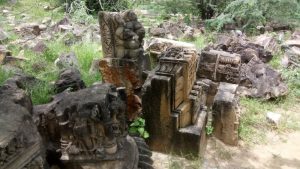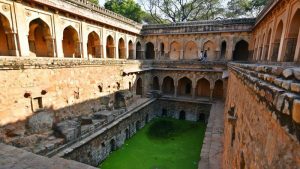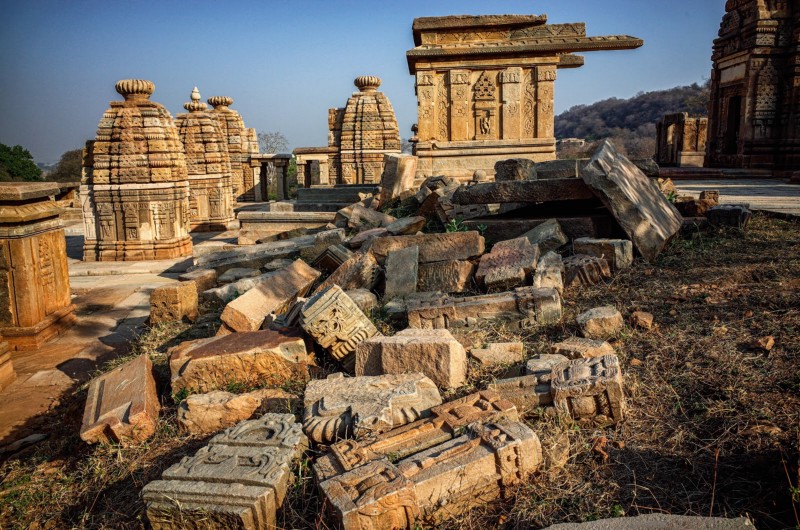Located near the Indo-Pak border of the Thar desert are the forgotten Kiradu temples of the Chalukya dynasty. Built in the 11th century, the temples, constructed in the Solanki style, are believed to be cursed. Legend has it that a Sage left a disciple in the care of the village of Kiradu but his wishes were not fulfilled. Enraged he cursed the people, and the lands have been deserted since. The nearest town, Barmer, is but 35 kms. Once part of a thriving trade route from Kandhar to Kutch, Barmer seems a shell of its former glory. Looks are often deceptive though. In 2009, crude oil fields were excavated in the district, attracting several Big Oil businesses from Cairn to ONGC with ambitious projects and no dearth of resources. Today wealth flows like a river across this barren-scape. In fact, Barmer is also the site of the largest oil heist in India!
Naturally, the economic boost has also incentivised the local populace to explore professions beyond herding and farming. Barmer’s surviving nobility of the Sodha dynasty has chosen to expand into hospitality with a vision to build on the area’s natural diversity of sand-dunes, salt lakes and migratory birds, and on its cultural legacy of Mangniyaar and handmade block-print fabrics. While the temple complex features prominently in their itinerary, its dismal condition is a woeful tale for all. The structures are officially charged under the care of the Archaeological Survey of India (ASI) and, more recently, the Indian National Trust for Art and Cultural Heritage (INTACH). On paper, funds have been allocated over the years for their restoration. In 2001, the 20 Year Perspective Plan for Sustainable Tourism in Rajasthan Report released by the Ministry of Tourism noted, as part of catalysing tourism in Rajasthan, an allocation of 110.00 lakh INR under the State Plan, and an additional allocation of 50.00 lakh INR by Centrally Sponsored Schemes for the development and refurbishment of the Kiradu Temple Complex. The responsibility of this refurbishment was bestowed on ASI. And yet, 18 years on, of the estimated 108 temples, only 5 remain. The last time repair work was carried out here was in 12th century, under the patronage of the Chalukya ruler Bhima II.

Ruins of the Kiradu Temple Complex, Rajasthan, 2017 | Source: Rishika Yadav
Why the complex remains ruinous despite the plentiful funding is a question for an RTI or PIL. Should it catch the attention of one of our many vigilant authorities, maybe a Committee will be appointed to investigate the matter. Although, as bureaucratic entanglements go, I suspect the curse of the raging Sage is responsible for this neglect.
Responsibility aside, Kiradu’s unfortunate fate is not unique. It is part of a larger narrative of crumbling histories spotting the country. Take the Capital for instance. The Mehrauli Archaeological Park is home to nearly a hundred monuments of the Sultanates of Delhi. The area, for the most part, is enclosed and has been allocated funds as part of ‘re-development’ projects by the Delhi Development Authority (DDA). Over the past two decades, these projects have, sometimes, solely been lead by DDA, sometimes by INTACH, and even a public-private partnership of both. The result? A rose garden, patches of maintained lawns with trails, and iron fencings around the more ‘significant buildings’. But the walls of the said buildings are badly damaged with engraved initials of lovers. Rajon ki Baoli which was once a source of water is now a stinky swamp, and the artistically tiled domes are now blackened. The Park itself is hard to find considering there is no sign board to welcome tourists. Only seasoned history walk-leaders can take you through the trail.

Rajon ki Baoli, Mehrauli Archaeological Park, Delhi, 2018 | Source: Sanchit Khanna, HT PHOTO
The sardonic twist in this particular narrative is that several of these monuments fall under the care of ASI — the very same ASI that is also responsible for the Qutub Complex, a UNESCO World Heritage, with which the Mehrauli Archaeological Park shares a lengthy boundary wall. Even the dead can’t escape the misfortunes of State control.
But then again, why should one care about dead kings and rotten buildings? Never mind the lakhs of crores of taxpayer money being ‘invested’ in their conservation, why should one care? Never mind the capacity of these monuments to boost tourism and diversify the economic spectrum of local populations, why should one care? Never mind the all-engulfing rage over ‘ownership’ of history every time Sanjay Leela Bhansali directs a movie, why should one care? Never mind that Italy, a country smaller than the state of Rajasthan, has the highest number of World Heritage Sites, why should one care?
Dead men tell no tales, why care indeed.
“[…] It has been most truly said at our meetings that these old buildings do not belong to us only; that they have belonged to our forefathers, and they will belong to our descendants unless we play them false. They are not in any sense our property, to do as we like with. We are only trustees for those that come after us. So I say nothing but absolute necessity can excuse the destruction of these buildings; and I say, further, that such a necessity has never yet existed in our time.” — William Morris, Address at the Twelfth Annual Meeting, Society for the Protection of Ancient Buildings, 1889.
A few years ago, United Kingdom found itself in a similar fix. Through the decades, UK had seen the formulation of several bodies to conserve the ‘assets’ of the country. The jumble of responsibilities between the various departments was all too real. In 1983, these numerous bodies were dissolved and re-constituted under a single commission, the English Heritage. Over the years, the office became responsible for built, material, and archival heritage, and even acquired responsibility for submerged ‘historic wrecks’ 12 miles off the English coast.
By 2010 however, the body was sustaining an annual deficit and the global recession was prompting budget cuts. As a country proud of its history and with a non-negotiable attitude on its preservation, the government found itself crumbling under this weight. To ease the burden, in 2015, the English Heritage was converted into a charitable trust of the same name and alloted a government investment of 80 million pounds. While the properties and heritage collections remain under Public ownership, the trust now has control over its finances and considerable autonomy in raising commercial and philanthropic funds. In exchange for the generous investment, the trust has proposed an ambitious eight year program to convert itself into a self-sustaining institution that acts as an advisory body to the Historic Buildings and Monuments Commission for England.
As Ed Vaizey, the then Minister of Culture expounded, “The consultation outlines how Historic England will look to get the heritage protection system to work better for owners, developers and infrastructure providers, reduce unnecessary bureaucracy and red-tape and support growth without reducing protection for heritage.” Although India is ridden with her own peculiar problems, there is value in the English lesson.
ASI has a history that pre-dates the Republic of India. Established in 1861, ASI is currently responsible for over 3,650 monuments of ‘national importance’, carries out excavations throughout the country, maintains a total of 44 museums and 7 publications and the National Archives of India — additionally, it routinely suffers budget cuts. ASI is also well-known for being plagued with a paucity of technical staff, manpower, resources, ill-advised transfers, and the usual red-tapism. Despite the limitations, to say that ASI is failing in entirety or has a lack of talent is bit of a stretch.
K. K. Muhammed, former Regional Director (North) of ASI, has several excavations to his credit. Of these, perhaps the most exciting project of all was a set of 200 temples, constructed between 9th to 11th CE by the Gurjara-Pratihara dynasty, that lay waste and was home to the Gadariya dacoits of the Chambal ravines. With no police protection and no guarantee of safety, the ASI team proceeded with the project. To ensure its success, Muhammed managed to get an audience with Nirbhay Singh Gujjar, the most wanted dacoit of the time who had 205 criminal cases to his name and ran a parallel government in 40 villages. He convinced the bandit of his responsibility to protect the temples by telling him of his ‘long lineage’ stemming from the Pratihara dynasty. With Gujjar’s death in 2005, Muhammed now had to deal with the mining mafia encroaching the region and he still had little police protection. In fact a Superintendent was shot dead at the Complex and another narrowly escaped with his life. On several occasions his team was ‘roughened up’ by the mafiosos. Unable to get the concerned authorities to intervene, as a final resort Muhammed wrote to the then RSS Chief K. Sudershan — and it took but 24 hours to get the wheels turning. In January of 2017, the restoration of all 200 temples was successfully completed, all thanks to an unrelenting man and his commitment to history. Indiana who?
The zeal is real, be it in ASI or INTACH or UNESCO or local communities. People do care but the mounting bureaucratic paperwork and the subjugation of initiative within this paperwork is a serious hindrance. Autonomy is the need of the hour.
Let me be clear though — what is being proposed here is not contracting the monuments. To contract a property, one must first have ownership of it. And as Morris aptly put it ‘they are not in any senses our property’. The idea is to privatise conservation, to give organisations like ASI and INTACH autonomy to harness the best possible technologies, to hire the right people, to raise philanthropic funds, to foster partnerships with local communities such as the noble house of Sodha and the dacoits of the Chambal valley — all to preserve our many histories, and to do so expeditiously.
This proposition itself is not a novel concept for India. Variations of it exist throughout. The past decade has witnessed the rise of private museums, such as the Kiran Nadar Museum of Art, constructed under the patronage of India’s business elite. In 2007 the Maharana Mewar Charitable Trust led the restoration of the Udaipur City Palace with funding from The Getty Foundation, USA and the Ministry of Culture, GOI. The Palace now houses a museum, a library, and a research institute.
In fact, granting independence to ASI is also not a new suggestion. The Mirdha Committee recommended that ASI be made autonomous and accorded the status of a scientific and technical institution — a suggestion that was accepted by the Government of India in 1989 but, 29 years later, this has still not been implemented! Rules yeah?
The model we currently have is neither sustainable nor effective. It is failing us, our ancestors, and our children. And why should it not? Consequent governments of free India have been consistently burdened with social responsibilities of healthcare, education, defence, financial self-sufficiency, and more. It is not surprising then that heritage is not too high on priority.
With this structural paradox in mind, it is time for the State to clean house and give motivated players a chance to ameliorate the cursed wonders of India.
Or must we be condemned to a suburban dystopia?
***
REFERENCES
1. Ferguson, A.F. & Co. (2001). 20 Year Perspective Plan for Sustainable 20 Year Perspective Plan for Sustainable Tourism in Rajasthan. Department of Tourism. Ministry of Tourism, Art and Culture. Government of India.
2. Brightman, M. (2012), Is the Conservation of the United Kingdom’s Built Heritage Sustainable?, Reinvention: A Journal of Undergraduate Research, British Conference of Undergraduate Research 2012 Special Issue, Retrieved April 7, 2018: www.warwick.ac.uk/go/reinventionjournal/issues/bcur2012specialissue/brightman.
3. Department for Culture, M. a. (December 2013). English Heritage New Model: Consultation .
4. Morris, W. (1989, July 3). Address at the Twelfth Annual Meeting — SPAB. Retrieved April 2018, from https://www.marxists.org/archive/morris/works/1889/spab16.htm
5. Rozario, J. (1217, April 12). Keeping Heritage Alive. Retrieved April 7, 2018, from Press Reader: https://www.pressreader.com/india/marwar/20170412/282213715670883
6. Srivathsan, A. (2007, July 21). Heritage at stake, strengthen the ASI . Retrieved April 7, 2018, from The Hindu: http://www.thehindu.com/todays-paper/tp-opinion/Heritage-at-stake-strengthen-the-ASI/article14800626.ece
7. Tripathi, S. (2012, June 01). Man of Monuments . Retrieved from The Hindu: http://www.thehindu.com/features/metroplus/man-of-monuments/article3480525.ece
Post Disclaimer
The opinions expressed in this essay are those of the authors. They do not purport to reflect the opinions or views of CCS.

